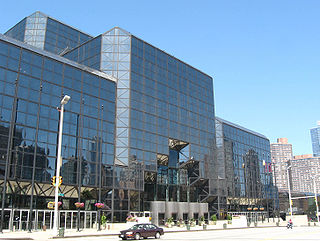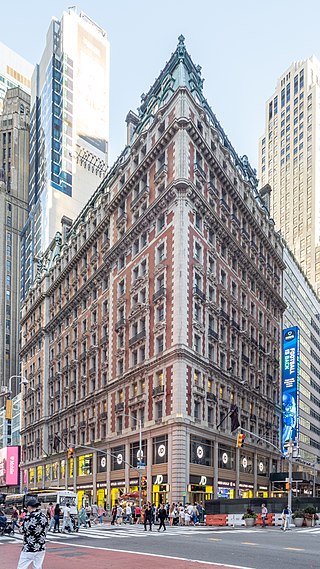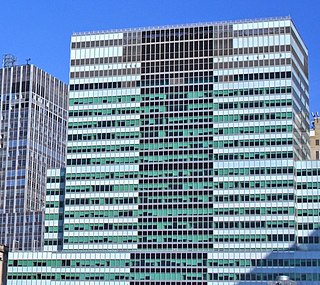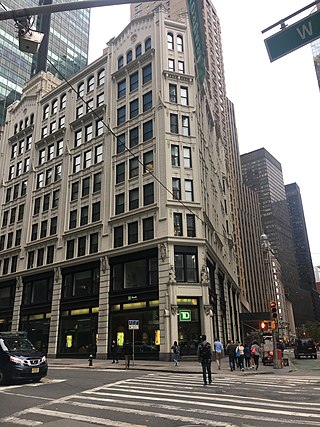
The Upper West Side (UWS) is a neighborhood in the borough of Manhattan in New York City. It is bounded by Central Park on the east, the Hudson River on the west, West 59th Street to the south, and West 110th Street to the north. The Upper West Side is adjacent to the neighborhoods of Hell's Kitchen to the south, Columbus Circle to the southeast, and Morningside Heights to the north.

Isidor Straus was a Bavarian-born American businessman, politician and co-owner of Macy's department store with his brother Nathan. He also served for just over a year as a member of the United States House of Representatives. He died with his wife, Ida, in the sinking of the Titanic.

Eleventh Avenue is a north–south thoroughfare on the far West Side of the borough of Manhattan in New York City, located near the Hudson River. Eleventh Avenue originates in the Meatpacking District in the Greenwich Village and West Village neighborhoods at Gansevoort Street, where Eleventh Avenue, Tenth Avenue, and West Street intersect. It is considered part of the West Side Highway between 22nd and Gansevoort Streets.

The John Golden Theatre, formerly the Theatre Masque and Masque Theater, is a Broadway theater at 252 West 45th Street in the Theater District of Midtown Manhattan in New York City. Opened in 1927, the Golden Theatre was designed by Herbert J. Krapp in a Spanish style and was built for real-estate developer Irwin S. Chanin. It has 800 seats across two levels and is operated by the Shubert Organization. Both the facade and the auditorium interior are New York City landmarks.

The Knickerbocker Hotel is a hotel at Times Square, on the southeastern corner of Broadway and 42nd Street, in the Midtown Manhattan neighborhood of New York City. Built by John Jacob Astor IV, the hostelry was designed in 1901 and opened in 1906. Its location near the Theater District around Times Square was intended to attract not only residential guests but also theater visitors.

1585 Broadway, also called the Morgan Stanley Building, is a 42-story office building on Times Square in the Theater District neighborhood of Manhattan in New York City. The building was designed by Gwathmey Siegel & Associates Architects and Emery Roth & Sons and was developed by David and Jean Solomon. 1585 Broadway occupies a site on the west side of Broadway between 47th and 48th Streets. The building has served as the headquarters of financial-services company Morgan Stanley since 1995.
The Weylin Hotel was a hotel at 527 - 531 Madison Avenue and 40 - 54 East 54th Street in New York City. It was on the southeast corner of 54th Street. The structure was sixteen stories tall and opened in March 1921. The building fronted sixty-one feet on Madison Avenue and one hundred forty-eight feet on 54th Street. It contained 125,000 square feet (11,600 m2) of space.
The Dauphin Hotel was an establishment located on the west block front of Broadway between 66th Street and 67th Street on the Upper West Side of Manhattan in New York City. In 1958, the ballroom of the hotel was behind Julia Murphy's Bar. The Dauphin Hotel was demolished as part of the excavation for the Lincoln Center for the Performing Arts. By 1964, the site was taken by the Empire Mutual Insurance Group building. This edifice also occupied the space where the Marie Antoinette Hotel previously stood. The area is currently occupied by a variety of retail stores including Raymour & Flanigan, Zara, and Pottery Barn, as well as a residential building.

The Marbridge Building is an office building at 1328 Broadway, on the east side of Sixth Avenue between 34th and 35th Streets in Herald Square, Manhattan, New York City. It opened in 1909, an 11-story structure, utilized in part by men's clothier Rogers Peet. Until October 1910 it stood opposite the Alpine apartment house, which was at the northeast corner of Broadway and 33rd Street. The Alpine and old stores between 33rd and 34th Streets were demolished to make room for the $5,000,000 Hotel McAlpin near the end of 1910. On the other side of Broadway were located the Macy's Herald Square and Saks Incorporated stores, with the Gimbels store just below.

The Crowne Plaza Times Square Manhattan is a hotel at 1601 Broadway, between 48th and 49th Streets, in the Theater District of Midtown Manhattan in New York City. The hotel is operated by third-party franchisee Highgate and is part of the Intercontinental Hotels Group's Crowne Plaza chain. It has 795 guest rooms.

2 Broadway is an office building at the south end of Broadway, near Bowling Green Park, in the Financial District of Manhattan in New York City. The 32-story building, designed by Emery Roth & Sons and constructed from 1958 to 1959, contains offices for the Metropolitan Transportation Authority (MTA). 2 Broadway serves as the headquarters for some of the MTA's subsidiary agencies.

Row NYC Hotel is a hotel at 700 Eighth Avenue, between 44th and 45th Streets, in the Midtown Manhattan neighborhood of New York City. The hotel is 27 stories tall with 1,331 rooms. Designed by Schwartz & Gross, with Herbert J. Krapp as consulting architect, it was developed by brothers Henry and Irwin Chanin and opened on February 1, 1928, as the Hotel Lincoln. The hotel largely retains its original brick-and-terracotta facade. The interior spaces, which originally included a lobby and various restaurants on the first three stories, have been redesigned substantially over the years.

The Pabst Hotel occupied the north side of 42nd Street in Manhattan, New York City, between 7th Avenue and Broadway, in Longacre Square, from 1899 to 1902. It was demolished to make room for the new headquarters of The New York Times, for which Longacre Square was renamed Times Square.

The Martinique New York on Broadway, Curio Collection by Hilton is a 532-room hotel at 53 West 32nd Street in Manhattan, New York City. It was designed by Henry Janeway Hardenbergh and built by William R. H. Martin, who headed the Rogers Peet business, in a French Renaissance style. The Martinique was developed in three sections between 1897 and 1911. The hotel is a New York City designated landmark and is part of the Historic Hotels of America.

287 Broadway is a residential building at the southwest corner of Broadway and Reade Street in the Civic Center and Tribeca neighborhoods of Lower Manhattan in New York City. The six-story, cast iron building was designed by John B. Snook in the French Second Empire and Italianate styles and was completed in 1872. Through the 19th and 20th centuries, it served as an office building before becoming a residential structure. 287 Broadway is a New York City designated landmark and is listed on the National Register of Historic Places.

The Mutual Reserve Building, also known as the Langdon Building and 305 Broadway, is an office building at Broadway and Duane Street in the Tribeca neighborhood of Manhattan in New York City. The 13-story building, constructed between 1892 and 1894, was designed by William H. Hume and built by Richard Deeves, with Frederick H. Kindl as chief structural engineer. It is just east of the Civic Center of Manhattan, and carries the addresses 305–309 Broadway and 91–99 Duane Street.
The Lincoln Arcade was a commercial building near Lincoln Square in the Upper West Side of Manhattan, New York City, just west of Central Park. Built in 1903, it was viewed by contemporaries as a sign of the northward extension of business-oriented real estate ventures, and the shops, offices, and other enterprises.

The Omni Berkshire Place hotel is located at 21 East 52nd Street, near Madison Avenue, in Midtown Manhattan in New York City. It is owned and operated by Omni Hotels & Resorts. The hotel was also inducted into Historic Hotels of America, the official program of the National Trust for Historic Preservation, in 2010.

224 West 57th Street, also known as the Argonaut Building and formerly as the Demarest and Peerless Company Building, is a commercial building on the southeast corner of Broadway and 57th Street in Midtown Manhattan, New York City, just south of Columbus Circle. The building consists of two formerly separate structures, the A. T. Demarest & Company Building and the Peerless Motor Car Company Building, both used by automobile companies. Both structures were designed by Francis H. Kimball and erected by the George A. Fuller Company with similar Gothic Revival and Romanesque Revival architectural details.
Manger Hotels was a major 20th-century national chain of luxury hotels, full service motor inns, and upscale motels. Originally founded in 1907 as a chain of luxury hotels by Julius and William Manger, the company shifted to extensive development of large strategically located motor inns and motels in the 1960s.

















